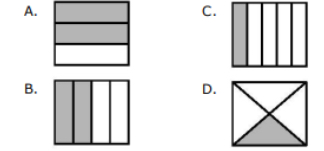General Information
Benchmark Instructional Guide
Connecting Benchmarks/Horizontal Alignment
Terms from the K-12 Glossary
- Number line
Vertical Alignment
Previous Benchmarks
Next Benchmarks
Purpose and Instructional Strategies
The purpose of this benchmark is for students to understand that unit fractions are the foundation for all fractions. Second, the purpose is for students to understand that fractions are numbers. This benchmark continues instruction of fractions from Grade 2, where students partitioned circles and rectangles into two, three or four equal-sized parts (MA.2.FR.1.1 and MA.2.FR.1.2).- To activate prior knowledge in Grade 3, instruction should:
- Relate how unit fractions build fractions to how whole-number units build whole numbers, and
- Show models with non-equal parts as non-examples (MTR.2.1).
- Unit fractions are defined as one part when a whole is partitioned in any number of equal parts. It is in this benchmark that students conclude that the greater a unit fraction’s denominator, the greater its number of parts.
- Instruction should demonstrate how to represent unit fractions using manipulatives (e.g., fraction strips, circles, relationship rods), visual area models (e.g., partitioned shapes), on a number line, and as 1 object in a set of objects (MTR.2.1, MTR.5.1).
- Denominators are limited in Grade 3 to facilitate the visualizing and reasoning required while students plot, compare and identify equivalence in fractions.
Common Misconceptions or Errors
- Students can misconceive the difference between the meaning of numerators and denominators in fractions. For this reason, it is important for teachers and students to represent unit fractions in multiple ways to understand how they relate to a whole. Representations can be modeled together (e.g., fraction strips side-by-side with number lines, or relationship rods side-by-side with number lines) to help build student understanding.
- Students can misconceive that the smaller the denominator, the smaller the piece, or the larger the denominator, the larger the piece. This is due to thinking and reasoning where students worked with whole numbers (the smaller a number, the less it is, or the larger a number, the more it is). To correct this misconception, have students utilize different models, such as fraction bars and number lines, which would provide students opportunities to compare unit fractions and to reason about their sizes.
- Students can misconceive that all shapes can be partitioned the same way. To assist with this misconception, have students practice with presenting shapes other than circles, squares or rectangles to prevent students from overgeneralizing that all shapes can be divided the same way.
Strategies to Support Tiered Instruction
- Teacher represents unit fractions in multiple ways to show understanding of how they relate to a whole. Representations are modeled together (e.g., fraction strips side-by-side with number lines, or relationship rods side-by-side with number lines) to help build understanding.

- Instruction includes partitioning shapes into different denominators.
- For example, students compare what they notice about partitioning a rectangle into halves versus fourths. Teacher asks students, “What do you notice about the pieces? How can we write what one piece of the rectangle is worth with a fraction?” Instruction includes the vocabulary of numerator and denominator.

- Instruction includes shapes other than circles and rectangles. Items like pattern blocks allow students to partition shapes like hexagons and rhombi into equal-sized pieces. This prevents students from over-generalizing that all shapes can be divided the same way.
- Instruction includes folding and/or cutting premade shapes into different amounts. Students benefit from beginning with halves and fourths, folding the paper in half, and then folding those halves into halves to make fourths.
- For example, the teacher asks students, “What do you notice about the shapes? About the size? We now have 4 pieces, Do we have more than we did before?&rdquo The conversation includes the size of the pieces and how that relates to the denominator.
Instructional Tasks
Instructional Task 1
Terry wants to show the unit fraction using an area model, a number line, and as a set.- Part A. Into how many equal parts should Terry partition his area model? How many of those parts should be shaded? Explain in words.
- Part B. Represent using the number line below.

- Part C. Draw a model that represents of a set of juice boxes.
Instructional Items
Instructional Item 1
Each model shown has been shaded to represent a fraction. Which model shows shaded?

 can be represented as
can be represented as  of a pie (parts of a shape), as 1 out of 4 trees (parts of a set) or as
of a pie (parts of a shape), as 1 out of 4 trees (parts of a set) or as